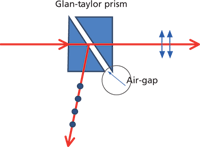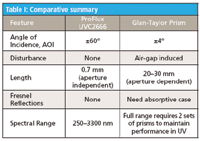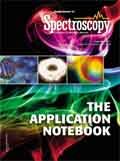UV-Vis-NIR Spectrophotometer Analyzer Comparison
Application Notebook
The Moxtek Proflux UVC266 analyzer improves UV–vis NIR spectrophotometer performance. As the analyzer polarizer, the UVC266 conserves space, offers an exceptionally wide cone acceptance angle, and has no disturbance issues as does the Glan-Taylor prism due to its air-gap.
The Moxtek Proflux UVC266 analyzer improves UV–vis NIR spectrophotometer performance. As the analyzer polarizer, the UVC266 conserves space, offers an exceptionally wide cone acceptance angle, and has no disturbance issues as does the Glan-Taylor prism due to its air-gap.
Figure 1 illustrates the light path for an instrument where traditionally the analyzer polarizer would be a Glan-Taylor prism. Typical polarizers used in this analyzer application are Glan-Taylor prisms. In the UV region especially, there is a need for better performance.

Figure 1: Simplified spectrophotometer with analyzer.
The ProFlux UVC266 polarizer by Moxtek offers an effective alternative with improved optical performance.
Comparison
Calcite, used for the manufacture of polarization components must be free from imperfections and inclusions that could scatter light. These prisms consist of two wedges of calcite anchored together with an air-gap. (see Figure 2).

Figure 2: Glan-Taylor prism.
The entrance angle is narrow, and any deviation results in significant additional light loss. Use of an air-gap results in losses due to internal Fresnel reflections which cause disturbances.
Glan-Taylor prisms have a 0.85 length-to-aperture ratio requiring proportionately more space for increasing aperture sizes.
Moxtek Proflux UVC266 polarizers have no "disturbances" over the entire spectral range of 250 to 3300 nm. The physical space required (0.7 mm thick) is a fraction of the space (20–30 mm for a similarly sized aperture) that a Glan-Taylor prism requires. Table I illustrates these differences.

Table I: Comparative summary
Angle of incidence (AOI) for a ProFlux UVC266 is ± 60o . This eases system design, enables all the light to be captured, and is an important factor in DUV and EUV applications where performance becomes increasingly demanding. The Glan-Taylor prism acceptance angle is ± 4o , and as the aperture size is increased, the performance in the UV region degrades. A UV Glan-Taylor prism may not function well in the IR region. The UVC266 is capable of covering the UV–vis–IR spectrum with the same part.
There is no need to encase the ProFlux UVC266 to reduce Fresnel reflections; conversely, an absorptive case is required for Glan-Taylor prisms to reduce, although it cannot eliminate, Fresnel reflections.
ProFlux UVC266 performance at 300 nm is 30% transmission and 10,000:1 contrast. A Glan-Taylor prism depends on the quality of crystal for transmission. Performance is normally 0.5 × 10-5 contrast, although in the DUV region, contrast can be 2000:1.
Conclusions
The ProFlux UVC266 polarizer answers the need for a better analyzer for spectrophotometers with improved performance throughout the spectrum and better performance in the UV region especially, while requiring significantly less space. The wide acceptance angle eases system design and improves performance.
Moxtek
452 West 1260 North, Orem, UT 84057
tel. (801) 225-0930; Email: info@moxtek.com
Website: www.Moxtek.com

Thermo Fisher Scientists Highlight the Latest Advances in Process Monitoring with Raman Spectroscopy
April 1st 2025In this exclusive Spectroscopy interview, John Richmond and Tom Dearing of Thermo Fisher Scientific discuss the company’s Raman technology and the latest trends for process monitoring across various applications.
A Seamless Trace Elemental Analysis Prescription for Quality Pharmaceuticals
March 31st 2025Quality assurance and quality control (QA/QC) are essential in pharmaceutical manufacturing to ensure compliance with standards like United States Pharmacopoeia <232> and ICH Q3D, as well as FDA regulations. Reliable and user-friendly testing solutions help QA/QC labs deliver precise trace elemental analyses while meeting throughput demands and data security requirements.